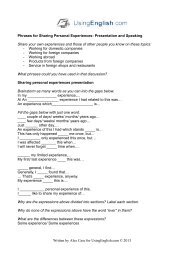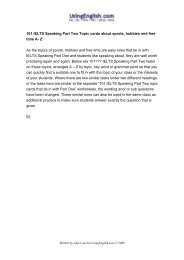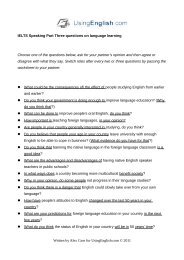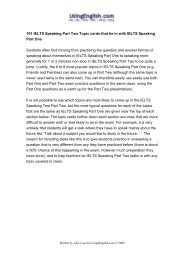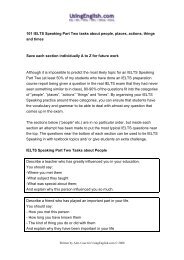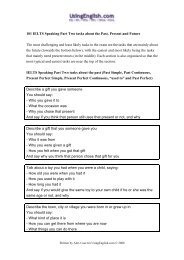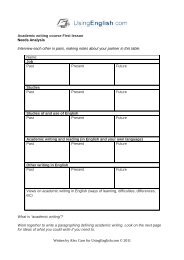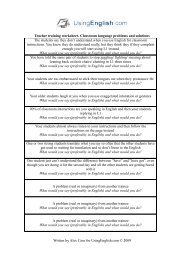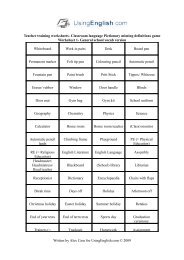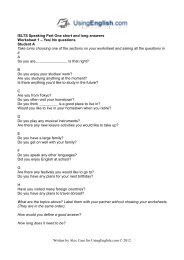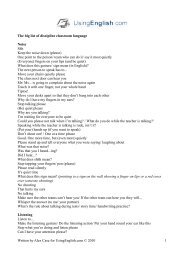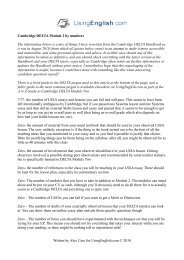Useful classroom language for moving around
Useful classroom language for moving around
Useful classroom language for moving around
You also want an ePaper? Increase the reach of your titles
YUMPU automatically turns print PDFs into web optimized ePapers that Google loves.
<strong>Useful</strong> <strong>classroom</strong> <strong>language</strong> <strong>for</strong> <strong>moving</strong> <strong>around</strong> in class and action games<br />
Gestures and body <strong>language</strong><br />
“Do the (English) gesture <strong>for</strong> ‘be quiet’/ ‘stop’/ ‘please’. Can you remember what it is?”<br />
“What does this gesture mean?... Good. Can you do the gesture and say what it means at the same<br />
time?”<br />
“Put your finger on your lips… Good, but pointing up… Got it. Now, what does that mean?”<br />
Moving desks and chairs<br />
“Move two/ three/ four desks together and put your chairs <strong>around</strong> them”<br />
“Push all the desks back against the walls”/ “Move your tables back (without making a noise/ one at<br />
a time starting at the front)”<br />
“Put your desks back where they were”<br />
“Put your desks into two lines/ rows with your chairs behind/ in front of them”<br />
“Leave your desks where they are and bring all your seats to the front”<br />
“Turn your chairs round (to face the…)”/ “Turn back to face the front”<br />
“Can you two take this table and move it over there? Thank you”<br />
“Any volunteers to move these tables?”<br />
“This table’s in the way, isn’t it? Where can we move it? Is there any space over there?”<br />
“Move your chairs (and tables) so you can all see the TV/ whiteboard/ students per<strong>for</strong>ming at the<br />
front”<br />
“Move them (a bit) further back/ <strong>for</strong>ward/ left/ right/ apart/ closer together/ towards the board”<br />
“Leave enough space to move <strong>around</strong>/ walk between the board and your desk”<br />
“Let’s make a (big) space in the middle/ at the front/ at the back/ in the corner of the <strong>classroom</strong>”<br />
“Please make sure the desks are straight”<br />
Standing up and sitting down<br />
“Stand up”/ “Everybody up (out of your seats)”/ “Stand behind your tables/ next to your desks/ in<br />
the aisles”<br />
“Sit down”/ “Take a seat”/ “Back to your seats”/ “You may sit down (now)”/ “Find yourself a seat”/<br />
“Sit up straight/ properly”<br />
Actions<br />
“Twist (your neck/ your wrist/ your waist)”<br />
“Turn (<strong>around</strong>/ all the way <strong>around</strong>/ 90 degrees/ 180 degrees/ 360 degrees)”<br />
“Keep your feet in the same position and…”<br />
“Jump (up and down/ <strong>for</strong>ward/ backwards/ sideways/ as far as you can/ towards…/ once/ with your<br />
feet together/ until I say ‘stop’/ until I shout out another action/ like a kangaroo/ like a rabbit/ like a<br />
frog/ quickly/ slowly/ onto the right flashcard)”<br />
“Hop (on your right/ left leg/ in a straight line)”<br />
“Wiggle (your leg/ arm/ finger/ fingers)”<br />
“Make a (small/ big) circle/ rectangle/ square/ triangle star shape/ letter… with your fingers/ arms/<br />
legs/ whole body”<br />
“Move like a fish/ helicopter”<br />
“Move more quickly/ slowly/ gently/ violently/ smoothly/ energetically”<br />
“Pretend your hand/ arm/ body is fin/ propeller/ spider/ man (and make it ski down your arm/ jump<br />
on your partner’s head”<br />
“Pass/ throw/ bounce the ball over your head/ under your legs/ to the person standing next to you/ to<br />
the person opposite”<br />
“Sit up straight/ Stand up straight”
“Spin (with one finger pointing out in front of you/ with your eyes closed/ <strong>around</strong> once or twice/<br />
quickly/ slowly/ anticlockwise/ clockwise/ in the opposite direction)”<br />
“Put this blindfold on/ Put this scarf <strong>around</strong> your eyes and move where your team tell you”<br />
“Open / close/ cover your eyes”<br />
“On tiptoes”<br />
“Hold hands (with your partner/ with the people on your left and right)”<br />
“Shake hands (with your partner/ with everyone you meet”<br />
“(Put your) hands up (when you know the answer/ if you want to go next/ if you spot a mistake”<br />
“Move <strong>around</strong> the class (and speak to everyone you meet/ and stop when I shout ‘Stop’”<br />
Directions<br />
“(Two steps) <strong>for</strong>ward/ backwards/ left/ right”<br />
“Towards the… (but not that far/ not touching it)”<br />
“Face/ Facing the board/ window/ teacher/ poster/ your partner/ the other team”<br />
“Turn your chairs back round and face the front”<br />
Positions, space and shapes<br />
“Can you come here, please?”/ “Can you come to the front of the class, please?”<br />
“Can you stand a little bit closer to/ further from the …?”<br />
“It’s time <strong>for</strong> a story/ a game/ the exit drill/ goodbye greetings, so go to the usual place/ where do<br />
we go to do that?”<br />
“Move a little bit closer to each other/ a little bit further apart (so that there’s room <strong>for</strong>...)”<br />
“You should be able to squat without touching anyone else/ spin round with your arms out/ touch<br />
three people without <strong>moving</strong> your feet”<br />
“There doesn’t seem to be enough room so continue the line along the wall/ start a new line/ split<br />
that line into two”<br />
“What’s that? I said a circle, not a jellyfish/ a straight line, not a squiggly line!”/ “What shape did I<br />
say?... And what shape is this?/ And is this a…?”<br />
“In the middle of the room”<br />
“On the mats I put on the floor”<br />
“In the corner (near the door)”<br />
“Touching the (back/ front/ left/ right) wall”<br />
“On the floor”<br />
“Squatting (like this)”<br />
“Sitting on your heels”<br />
“Behind/ in front of/ next to your desk”<br />
“Near the window/ teacher’s desk/ door/ pegs/ cupboards”<br />
“Stand in/ Make a circle (and hold hands)”<br />
“Stand in a line<br />
“Hands on your heads/ shoulders/ ears/ knees”<br />
“Turn and face the…”<br />
“Turn all the way round”<br />
“Face the other way”<br />
“Stand behind the line”/ “Imagine there is a line from here to here/ from the edge of the window to<br />
the teacher’s desk and stand behind that line”<br />
“Stand about one metre apart/ so you can just touch your partner if you hold your arms out/ well<br />
apart from each other”/ “Can everyone stretch out their arms (to the side/ in every direction/ all<br />
round) without touching anyone/ anything?”<br />
“Sit under the piano. Go!”<br />
“Touch your desks with your noses”<br />
“In two (straight) lines”
“(A bit) further apart”/ “Please leave enough space (<strong>for</strong> me/ the other students to get through)”<br />
Miming/ pretending<br />
“Pretend you are a monkey/ banana/ letter A”<br />
“Pretend you are holding/ eating/ making/ lifting up a cake/ gun/ elephant”<br />
“Pretend you are in a small cupboard/ on a tightrope/ in the middle of a road/ between two hippos<br />
on the bus”<br />
Danger<br />
“Make sure you don’t touch/ knock over the OHP/ fish tank”<br />
“Don’t touch the wall too hard (or you could go through!)”<br />
“(Be careful.) There’s a sharp corner here”<br />
“Remember that someone hurt themselves on this/ in this game last week”<br />
“If you push, someone will get hurt”<br />
“You’ll hurt yourself if you do that again”<br />
Disturbance<br />
“No shouting.”<br />
“Don’t jump so much, the class downstairs can hear you”<br />
“Don’t bang into the whiteboard, the whole wall is going ‘bang’. From now on, everyone only<br />
touch the card with your index finger. Hold out your index fingers. Good. Now, let’s try that”<br />
“That was a bit noisy. Let’s try it again, but this time sliding your feet along the ground like you are<br />
skiing. Let’s practice that first. Ski! Ski! Good, that’s better. So, this time when I say ‘go’, do the<br />
same but skiing instead of running.”<br />
“Plus one point to the boys <strong>for</strong> finishing first, and minus one point <strong>for</strong> the boys <strong>for</strong> making too<br />
much noise.”<br />
Other rules<br />
“You can/ can’t (only) use your hands/ both hands/ your head”<br />
“The first person to do the right action gets a point/ is the winner”<br />
“Anyone who does a different action loses one point/ is out of the game/ is out <strong>for</strong> one round/ has<br />
one more chance and then is out of the game/ has to go to the back of the row/ is the crocodile next<br />
time”<br />
Going back<br />
“Go back to your seats”/ “Back to your original positions”/ “Return to your places please”/ “Please<br />
return to your seats (quickly)”<br />
“Put your desks back how they were/ in the original way/ in the usual way”<br />
“Return your chairs to their regular places”/ “Move your seats back to where they came from/<br />
where you got them from”<br />
“Go back and work with your original partner”<br />
“I didn’t see who was first, so go back to where you were”<br />
Getting into groups<br />
“Change partners” [point to one person with your right hand and one person with your left and then<br />
move the two hands until they are pointing at the opposite places, then repeat a few times]<br />
“Work with someone that you have never worked with/ who you haven’t worked with today/ this<br />
week”/ “Find someone new to work with”<br />
“The people I point to, swap seats”<br />
“Stand up and find someone to work with/ and <strong>for</strong>m groups of three/ and pair up with someone you<br />
haven’t worked with today”
“Sit in the same teams as be<strong>for</strong>e/ last week/ last lesson/ always”<br />
“Anna, can you move over there?”<br />
“We need one more person in this group/ team. Can someone (from that group/ team) come over<br />
here and join them? Bring your chair/ You don’t need to bring your chair”<br />
“Stand up and make groups of three”<br />
“Sit down now and work with the person next to you”<br />
“People who are wearing blue, sit over here. People who aren’t wearing blue will be in this team<br />
over here”<br />
Stopping and waiting<br />
“Stand still!”/ “Don’t move”/ “Stay in your places/ where you are (until I finish explaining/ until the<br />
other team has moved)”<br />
“Who can stand the stillest?”/ “How long can you stand totally still?”<br />
“Perfect, stay right there!”<br />
“Ready, steady, go!”<br />
“Wait <strong>for</strong> it. Wait <strong>for</strong> it! Go!”<br />
“Five. Four. Three two one go!”<br />
“Wait until I say ‘go’”<br />
“Just a minute, I’m going to explain the game/ the rules/ the <strong>language</strong> you need first”<br />
“Freeze!”<br />
“Stop!”<br />
One at a time and other variations and limitations<br />
“Just the boys/ girls/ people wearing blue/ the people I gave a number five to/ the team captains/ the<br />
person holding the ball, stand up/ come here/ stand in front of the board”<br />
“Okay, now the same game but jumping/ hopping/ walking backwards/ walking slowly”<br />
“Without (using your…)… try to …”<br />
“Come up one at a time and get your marked tests/ read your homework books to me/ pin your<br />
posters on the notice board”<br />
Giving the kids control of the actions<br />
“What action shall we do next?”/ “Can anyone think of a new action?”<br />
“Can someone write the next action on the board?”<br />
“Someone choose a flashcard with the next action on/ choose an action from the board”<br />
“Who wants to be teacher?”<br />
“What else can you touch/ go under/ pick up/ run <strong>around</strong>/ mime (driving/ drinking/ eating)?”<br />
Physical pronunciation practice<br />
“Chop your left palm with your right hand with the rhythm of the song/ sentence/ word stress”<br />
“It you hear ‘can’t’ raise your left hand, and if you hear ‘can’ put up your right hand”<br />
“Jump to the right if you hear /sh/ and jump to the left if you hear /s/”<br />
“If the word has two syllables/ beats touch your shoulders, and if the word has one syllable/ beat<br />
touch your nose”<br />
“Run and touch the flashcard with the sound that you hear”<br />
Action songs<br />
“As you listen to the song, I want you to mime the things/ animals/ letters you hear/ that we<br />
practised”<br />
“Mime the action <strong>for</strong> the person who is singing (<strong>for</strong> example when the father sings, pretend to<br />
stroke your beard)”
“The first time that we listen, just do the actions that you hear. Then we will sing along when we<br />
hear it a second time”<br />
Miscellaneous<br />
“One point <strong>for</strong> the first team in the right position/ <strong>for</strong> the first team with their chairs and tables back<br />
in position/ <strong>for</strong> the first team standing quietly in a nice straight line”<br />
“We are going to do the same song/ activity/ game as last time, but this time standing up/ <strong>moving</strong><br />
<strong>around</strong>/ in a circle/ in lots of little circles instead of one big one”<br />
Using <strong>classroom</strong> <strong>language</strong> <strong>for</strong> describing action games<br />
1. Action chains<br />
“What does this say next to number one on the whiteboard? /s/ /t/ /ae/ /n/ /d/ …Good, now say all<br />
the sounds quickly together… Great, ‘stand’. So what do you think the next word is? /u/ /p/<br />
makes…?... ‘Up’. So the whole thing says…? That’s right, ‘stand up’. So, what do you think I want<br />
you to do?... Great, you’ve got it! Wait <strong>for</strong> it! So, good, I want you to stand up, but at the same time<br />
I want you to say the words on the board as quickly as possible as you do the action. So, say these<br />
words quickly. ‘Stand up!’… Great, but quicker… Superb! Now if it says stand up in number one at<br />
the top of the board, what do you think I am writing here next to number 15 at the bottom? /s/ /i/<br />
/t/ /d/… Good guess, ‘sit down’. So in a minute you are going to do this action next to number one<br />
and this action next to number 15 as quickly as possible while saying the sentences. Ready, steady,<br />
go!... Okay, good. Let’s do it one more time but more quickly and saying the words on the board.<br />
First let’s practice saying the sentences one more time. I can’t hear anyone over here speaking. One<br />
more time…. Right, now with the action and shouting out the words at the same time…. Got it!<br />
Now you are ready <strong>for</strong> number two. What am I writing next to number two now? /j/ /u/ /m/ Can you<br />
guess the last letter?... /p/, that’s right. So?... ‘Jump’, that’s right. So, let’s say all three sentences<br />
and then do the actions as quickly as possible. No, stop. Just speaking this time. Stand… Great, now<br />
with the actions. Wait <strong>for</strong> it! On your marks, get set… go! Excellent. Okay, so let’s add number<br />
three…”<br />
2. Stations<br />
“What does this card I am putting up here on the board say?... Can you remember what the sound of<br />
T and H together is?... Good. And we know this last word, don’t we? Good, ‘is’. So, what structure<br />
were we studying last week that starts with /th/ and ends with ‘is’?... ‘There is’, well done Johnny.<br />
Can everyone repeat that?... Good, but stick your tongues out this time. All together, one, two,<br />
three… Great. And here on the opposite wall I’m going to put some words which are similar but<br />
different. Can anyone guess what it says?... ‘There isn’t?’ Let’s have a look at the card and see,<br />
shall we? Nearly right, there… are, good. So this one is…? Good. And this one? This one? This<br />
one? This one again? This one? This one? Wow, so quick, well done. So, in a minute I’m going to<br />
get you to stand up and when you hear ‘there is’ you run [mime running] and slap [mime slapping]<br />
the ‘there is’ card. Which one is that? Yup, that’s right. But, if you hear ‘there are’ you have to run<br />
all the way to the other side of the room. The last person [mime running very slowly or standing in<br />
the middle of the room looking confused] to touch the right one has to sit down and is out of the<br />
game [mime sitting down with shoulders hunched and a disappointed look on your face] Got it? Are<br />
you sure? Any questions? No? Okay, stand up in the middle of the room.”<br />
3. Running dictation<br />
“Can you see the words on this piece of paper? …No? What can we do??... No, sorry, I can’t take it<br />
off the wall, it must be superglued on! [mime trying to tug it off with all your <strong>for</strong>ce and failing] Any<br />
other ideas?... Mmm hmm, good idea. You could come up here and look at it. I know what you lot<br />
are like though, it’ll be [mime running, pushing, shouting and other chaos]. So, half of you are
going to come up and look at the paper and half of you are going to stay sitting down. So, everyone<br />
find a partner and one person in each pair stand up… Juan, who’s your partner?... Good, so one of<br />
you stand up then. Hristov, no partner?... Ah, I see, odd numbers. Do you want to come over here<br />
and make a three then? No need to bring your chair, there’s already one here…. Right, I think<br />
we’ve got it. I see everyone wanted to be the one sitting down. Bad choice, ha ha! Each person<br />
sitting down needs a pencil and a blank piece of paper, and you’ll need to write down everything<br />
from this piece of paper at the front without standing up. Anyone got a telescope or binoculars<br />
[miming them with hands <strong>around</strong> eye]? No? Aha, but you do have…? A robot?? Good imagination!<br />
Well, he could be a robot, but anyway you have your partner who can come up to the paper [walk<br />
up to the paper], look at it [index fingers from eyes to piece of paper], and remember [tap side of<br />
head with index finger]. Then you walk back to your partner and tell them everything you<br />
remember [mime talking, blah blah blah] so they can write it down [squat to pretend to be the<br />
person sitting down and writing with an imaginary pencil] until you can’t remember any more,<br />
eeeerrrrrr, give up! Then they can walk back to the front and do the same again. Whenever you<br />
think you have finished [gesture ‘finished’ by brushing dust off hands or making the cutting motion<br />
with palms down] put up your hands and I’ll come over and check. If it’s perfect [thumbs up], you<br />
are the winners [fists raised in air], but if there are mistakes [frowning face], you’ll need to start<br />
again [mime standing in starting position <strong>for</strong> a sprint]. Got it?... Are you ready?... I didn’t say ‘go’, I<br />
said ‘Are you ready?’… Yes? Okay, three more rules be<strong>for</strong>e we start. No pushing [mime it], no<br />
shouting [hands <strong>around</strong> mouth as loud hailer] and fast walking is okay but no running [mime<br />
keeping legs straight as walk quickly]. What were those rules again? No…? And no…? And no…?<br />
Good, but what is okay?... Right. Go!”<br />
Language Analysis<br />
• Tick the phrases above that you have already used in your classes<br />
• Put a star next to one phrase in each section above that you would most like to use in class.<br />
Would you want to change those sentences at all to make them totally suitable <strong>for</strong> your<br />
classes?<br />
• Underline all the praise and other positive <strong>language</strong> in the phrases and extended <strong>classroom</strong><br />
<strong>language</strong> examples. How much of this kind of <strong>language</strong> do you use? Which ones do you<br />
use? Which ones would you like to use?<br />
• Circle the general <strong>language</strong> of requests and other polite <strong>language</strong> above. Do you think this is<br />
necessary with kids’ classes? Would you use more or less than there is above? Change a few<br />
examples to make them imperatives or more polite.<br />
• Are any of the gestures possible <strong>for</strong> students to misunderstand? How could you replace them<br />
with other gestures or make the meaning of the gestures clear? Can you add similar gestures<br />
to any of the other phrases?<br />
Thinking points/ discussion questions<br />
• Look at the instructions <strong>for</strong> the running dictation. Do you think it would have been easier to<br />
explain the whole game be<strong>for</strong>e getting them into pairs? Try explaining it that way and see if<br />
it turns out to be clearer and/ or more motivating <strong>for</strong> the students.<br />
• Are any of the actions too childish <strong>for</strong> your students, e.g. would they be embarrassed by<br />
doing any of them?<br />
• Are any of the instructions impossible in your <strong>classroom</strong>, e.g. pushing all the tables back to<br />
the wall? What is the closest equivalent you can do and what instruction <strong>language</strong> would<br />
you use to explain it to your children?



